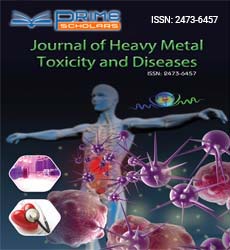Commentary - (2022) Volume 7, Issue 1
A Comparative Morphological Assessment of Poisonousness Substance (toxicity) and Compound Carcinogenesis.
George Leo*
Department of Science and Chemistry, University of the Cambridge, UK
*Correspondence:
George Leo, Department of Science and Chemistry, University of the Cambridge,
UK,
Email:
Received: 05-Jan-2022, Manuscript No. IPJHMCT-22-13284;
Editor assigned: 07-Jan-2022, Pre QC No. IPJHMCT-22-13284 (PQ);
Reviewed: 21-Jan-2022, QC No. IPJHMCT-22-13284;
Revised: 26-Jan-2022, Manuscript No. IPJHMCT-22-13284 (R);
Published:
02-Feb-2022, DOI: 10.21767/2473-6457.22.7.1.2
Description
Engineered intensifies cause hurtful and disease causing impacts
as well as productive and other disagreeable effects in
animals and in individuals. The justification behind this paper
is to study whether there is a quick, uniform causal association
among noxiousness and malignant growth causing nature. Inside
this remarkable situation, unequivocal issues get thought:
the effect of transparency obsessions with carcinogenesis; kidney
infection and alpha 2 mu-globulin; urinary calculi and developments;
and cell turnover or extension and sickness. The
data used to survey histopathological site-unequivocal correspondence
between these two end-centers comes from 130
examinations of compound carcinogenesis arranged and drove
by the US National Toxicology Program (NTP). Just about 1500
sex-species-receptiveness bundle tests were evaluated for
morphological evidence of toxicity as well as disease causing
nature, for segment response associations, and for site-express
connections of destructiveness and malignant growth causing
nature. The huge closures are that manufactured mixtures surveyed
for long stretch hurtfulness and disease causing nature
in preliminary animals can be parceled into three orders: those
that cause organ toxicity without dangerous development,
those that cause site-express illness with no connected destructiveness
and those that cause harmfulness and infection
in a comparative organ. Models are given to outline each class.
In view of this relative assessment, in the remarkable bigger
piece of cases the available data don’t maintain a connection
between’s artificially started destructiveness and disease causing
nature. Also, until amazingly more legitimate data about
sub-nuclear frameworks of carcinogenesis opens up and recognized,
tries to use disclosures on hurtfulness to modify the bet
assessment cycle will be loaded with weakness and could even
antagonistically influence general prosperity. The preliminary enlightening assortment used to evaluate site-unequivocal histopathologic
correspondence between the morphologic end
points of hurtfulness and disease causing nature includes 130
engineered carcinogenesis studies. Just about 1500 sex-species-
transparency bundle tests were surveyed for confirmation
of destructiveness or/and disease causing nature, segment
response associations, site-unequivocal connections of toxicity
and malignant growth causing nature, and correspondence
with Salmonella mutagenicity. The critical finishes are that
manufactured substances surveyed for long stretch hurtfulness
and malignant growth causing nature in exploratory animals
segment typically and dependably into three classes: fabricated
materials causing organ harmfulness without threatening development,
engineered intensifies causing site-express illness
with no connected toxicity, and manufactured substances causing
both noxiousness and dangerous development in a comparable
organ. Relatively few engineered materials overall (and
none in this instructive assortment) fit the extra assembling
that cause neither noxiousness nor malignant growth causing
nature under these show conditions. Mutagenicity showed no
anticipated model with any of these groupings. Only 7 of 53
“positive” engineered materials had target organ harmfulness
at all objections of disease causing nature. Just three manufactured
substances showed disease causing impacts at the most
critical receptiveness centers without supporting verification of
developments at the lower levels.
Conclusion
From these general morphological examinations, and for all
intents and purposes all cases, open data don’t maintain an
association between’s artificially incited harmfulness or regenerative
eccentricities and malignant growth causing nature.
Hence, until intelligent data about nuclear frameworks of substance carcinogenesis ends up being better seen and overall
recognized, attempts to use destructiveness disclosures to
change risk examination cycles will be brimming with weakness
and in this manner could antagonistically influence general
prosperity.
Acknowledgement
None.
Conflict of Interest
The authors declare no conflict of interest.
Citation: Leo G (2022) A Comparative Morphological Assessment of Poisonousness Substance (toxicity) and Compound Carcinogenesis. J Heavy Met Toxicity Dis Res.7:2.
Copyright: ©Leo G. This is an open-access article distributed under the terms of the Creative Commons Attribution License, which permits unrestricted use, distribution, and reproduction in any medium, provided the original author and source are credited.

